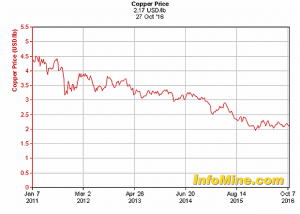A conference recently held in London has determined that copper will play a vital role in promoting a greener, clean and more sustainable world.
Stakeholders in the copper industry have had it rough for quite a while now. The metal which used to fetch more than USD $4.50 a pound in 2011, had its value plunge below $2.50 at one point in October.
It’s clear that the rough days aren’t over just yet. In August this year, Goldman Sachs predicted the price could dip to USD $4,000 a tonne over a period of 12 months as growth in demand softens while supply picks up.
Globally, the copper sector is expected to produce about 22.5 million tonnes of the metal in 2016, an increase of 3.6 per cent above last year’s figure.

But may be the soft demand situation might not last for long.
The Chief Executive of the International Copper Association, Jean-Sebastien Jacques; recently delivered a speech at a technical workshop in London about the future of copper—and was quite optimistic on the future prospects of the metal.
He noted that clean energy resources needed about 4 to 12 times more copper compared to the traditional fossil fuel-based electricity generation. Mr. Jacques added that one megawatt produced by solar photovoltaics utilises around four tonnes of copper.
According to the International Energy Agency (IEA) forecasts, the PV capacity by 2030 will lie anywhere between 1,750 and 2,500 gigawatts. This translates to between 7 and 10 million tonnes of copper required to fully meet the demand related to solar energy systems alone.
It should also be noted that the IEA is always known to underestimate the rise of solar. The new revised forecast released by the IEA almost a fortnight ago states that 30,000 solar PVs will be installed every hour across the globe over the next 5 years. In addition to this demand, copper is to be used in the manufacturing of electric vehicles (EVs).
“With 90 or more kilos of copper used in a full electric vehicle – three to four times more copper than used in a gas-powered car – it is clear to see the positive impact the use of electric vehicles could have on copper demand,” Mr. Jacques said.
On the other end, Bloomberg New Energy Finance predicts that by 2040, over 40 million totally electric vehicles will be sold per year.
The high demand for copper will only mean more of mining—which is likely to send shock waves down the spines of most environmentally conscious people. However, the most encouraging thing about copper, unlike coal and crude oil is that it is recyclable.
“It can be used again and again without any loss of its properties, including its high level of conductivity,” he stated. “One-third of copper demand today is met from recycled metal.”
Mr. Jacques acknowledges that the copper industry has to do much better in securing a social license, terming it “a make or break” scenario based on its future activities.
“We must demonstrate how we will share the benefits created by our operations, and how we will partner with local communities and host governments. We also must explain what we are doing to ensure the long-term sustainability of the planet and its seven billion people,” he added.
The entire text of the speech can be viewed here (PDF).
It should be kept in mind that more copper means increased production of graphite, from which grapheme is created– another valuable component in the renewable energy industry for application in next generation solar energy and battery solar storage products. Graphite is one of the by-products of copper mining.
Image credit: Jonathan Zander (Digon3)
